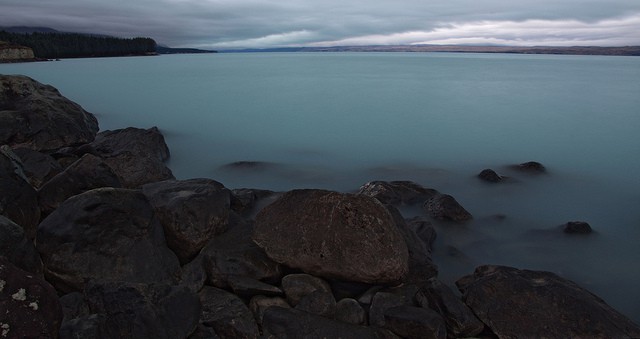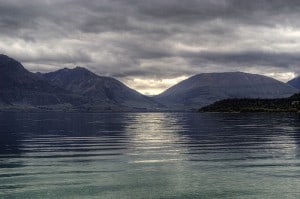In these last days of summer I have been binging on a 30-day free trial of Netflix. I’m not proud of being glued to my computer for a month, but I am impressed by what I’ve seen. There’s some good television out there and also, as is fitting for the medium, a sea of junk. Art imitates life I suppose—the good, the bad, and the crappy. Let’s stick with the good.
Jane Campion’s Top of the Lake stands out in the flood of shows available on demand. Reviewers have said that it’s the best show on TV that you probably haven’t seen. If this is true I wouldn’t blame you. It appeared only briefly this summer on the Sundance channel and is now available exclusively to Netflix subscribers.
Oh yeah, and it’s a real bruiser. Drugs. Sex. Violence. Blood. Bones. Bodies. Memory. Regret. Missing Persons. It’s pretty dark stuff for summer entertainment.
In the opening scene of the series the body of a young girl is pulled from a lake. Unlike the first shot of most crime shows, she is still alive. She has waded into the water, presumably to commit suicide, but is pulled out by a passing woman. Offering her some dry clothes the passerby discovers that the 12-year-old girl is noticeably pregnant. Intriguingly, we see the victim alive and interrogated before she goes missing. When asked by an empathetic detective about her pregnancy, she reveals in a cryptic note that ‘NO ONE’ did this to her. And then, after being returned to her far less-than-perfect home, she disappears.
We’re left to sort out a difficult mystery: what do we do when ‘NO ONE’ is the suspect? How do we live with pain in a place where there is no one to blame? Actually, in this case and in many others, it appears that every one is to blame instead of “no one.” It’s a small town, locked in by mountains, where everybody knows everybody else. But no one is talking. How do we live in a place where everyone is suspect, everyone abused, and everyone a perpetrator?
There are sins we commit as individuals and there are others we hold in common – social sins, systemic oppression, institutionalized evil, and generations upon generations of disordered relationships. When sinfulness is shared, the ones who suffer its effects feel ashamed, especially if no one acknowledges the truth or accepts responsibility. Stuck in a Mobius strip of guilt we can become isolated and paralyzed by pain.
Eventually one character in the show makes a heartbreaking admission. In the midst of all the pain and suffering, all the shame and confusion, she curls into a ball and stutters a simple confession, not of guilt but of despair. She speaks something that we feel all too often when our pain overwhelms us, when we have no place to put it. She says sadly, “I don’t know how to keep living.”
***
This is familiar ground. I was once in a place where I didn’t know how to keep living. I prayed there, imagining myself at the foot of the cross, and in that place I came to understand something about sin and suffering: it gets us all. No one escapes life without it, and in a certain sense we’re not meant to be responsible for it, only to bear it. A felt freedom came to me when I realized that I wasn’t solely responsible for my pain, or for the pain of people I love. Sometimes shit just happens.
Adoration of the crucifix is a curious thing. Why contemplate the suffering of innocence? I won’t pretend to offer an explanation of sin or redemption here, but in that moment of prayer I came to understand how sin can be inherited and how suffering is passed around like a dangerously dark gift. Perhaps at the foot of the cross we realize a need for redemption so deep that only God can bear it, so we give it up and keep watch.
This is not to deny accountability and guilt, but rather to avoid silence and shame. Sometimes there is not merely a mystery to be understood but a story to be told. Sometimes to ‘solve’ a crime is simply to acknowledge it and to live with it. If I can name the crime, if I can find someone to witness it, this is all I need to ‘solve’ it. More than retribution, I think we crave restoration. We’re not merely interested in who deserves to die for pain, who did it, but how to keep living when we don’t know how to bear it.
Artistic merit and aesthetic appeal are rooted in honesty. The characters in Top of the Lake do what people do in pain and confusion—they flail, they fight, and they f**k. They get disturbing news and they go buy a pack of cigarettes or a bottle of wine. They call or text someone they know they shouldn’t, someone they haven’t seen by the light of day in years. They cut. They smoke. They kick. They punch. They drink. They do the only thing that helps — they hurt.
And we watch.
***
The truth we need to know, the one we hope to discover, is the truth that speaks meaningfully to the experience of suffering and pain – it’s the truth of witness. In this show there’s only a mystery because everyone has a motive, even the viewers. We watch because we want to be witnesses to the pain we know too well. We watch because in seeing it, we solve it.
We may see too many of these stories on television but we probably hear too few of them in our real lives. Top of the Lake bears unexpected good news, then: There are too many sad stories to tell and too many for us to hear. But, if we’d like to keep more bodies on top of the lake than beneath it, then we better listen to them all. We better keep watching.
***
The cover image, by Flickr user Chris Lindsay, can be found here.




